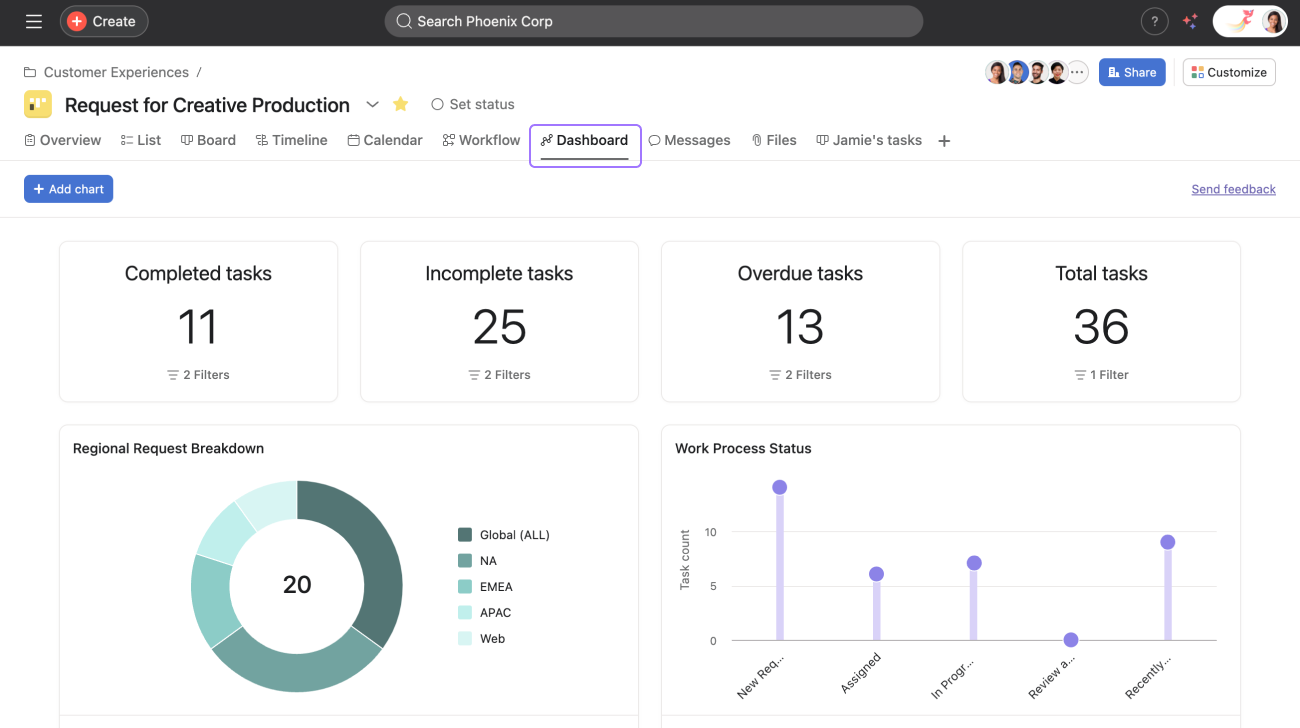Asana AI Project Management for Remote Teams
Project Management for Remote Teams
Asana AI represents a mid-market AI-powered project management platform that transforms traditional task coordination into intelligent workflow automation. Asana AI leverages OpenAI and Anthropic LLMs to automate project management workflows, delivering contextual automation that references project-specific data when generating insights [3][18].
Market Position & Maturity
Market Standing
Asana AI occupies a strategic mid-market position in the AI project management landscape, competing directly with Monday.com and ClickUp while positioning above entry-level tools and below premium enterprise platforms like Celoxis [17][18][27].
Company Maturity
The company demonstrates strong market maturity through established enterprise customer relationships including Morningstar, Coupa, Danone, and Zoom [12][13][14][15].
Growth Trajectory
Growth trajectory evidence shows expanding AI capabilities with 2025 roadmap including multi-agent workflows through AI Studio enhancement [7][9].
Industry Recognition
Industry recognition includes positioning in AI project management category analysis, though specific analyst rankings need verification [11][18].
Strategic Partnerships
The platform demonstrates strategic partnership ecosystem through OpenAI and Anthropic LLM integrations, indicating strong vendor relationships [3].
Longevity Assessment
Longevity assessment reveals strong indicators through established customer base, continuous product development, and enterprise-grade security compliance [3][10][12].
Proof of Capabilities
Customer Evidence
Documented customer success across diverse industries including financial services (Morningstar), SaaS (Coupa), manufacturing (Danone), and technology (Zoom) [12][13][14][15].
Quantified Outcomes
Quantified performance outcomes include 83% time savings for UX teams using AI Studio for customer research tasks through automated interview transcript analysis [7]. Smart Fields implementation shows 40% reduction in metadata setup time through intelligent field suggestion and population [2][3]. AI-driven status updates demonstrate 70% reduction in weekly reporting time for product launch teams [8].
Case Study Analysis
Morningstar's financial services deployment reduced workflow intake timelines by 2 weeks using AI-driven request vetting that auto-evaluates submissions against criteria and recommends resource allocation [12]. Coupa's SaaS implementation delivered 135 workdays saved annually by consolidating cross-team projects through AI-powered intake forms that prioritized initiatives via numerical scoring, reducing duplicate work [14].
Market Validation
Market validation evidence shows teams of 50 employees saving $18,000 annually in administrative costs through Smart Rules automation [2][11].
Competitive Wins
Competitive wins demonstrate Asana's Smart Goals functionality outperforming Monday.com in strategic alignment scenarios, while the platform's intuitive AI adoption serves as a key selection factor for SMBs [17][11].
Reference Customers
Reference customers span financial services, SaaS, manufacturing, and technology sectors, demonstrating cross-industry applicability [12][13][14][15].
AI Technology
Asana AI's technical foundation integrates multiple LLM providers (OpenAI and Anthropic) to deliver contextual project intelligence rather than generic automation [3].
Architecture
The platform's AI architecture centers on three core technologies: Smart Projects for automated project structure generation, Smart Workflows for natural-language rule creation, and AI Studio for custom agent development [3][5][7].
Primary Competitors
Monday.com and ClickUp [17][18][27].
Competitive Advantages
Primary competitive advantages include Smart Goals functionality for strategic alignment absent in Monday.com and contextual automation that references project-specific data unlike ClickUp's generic meeting summaries [5][17][18].
Market Positioning
Market positioning emphasizes ease of AI adoption for SMBs and strategic project alignment for mid-market organizations [11][17].
Win/Loss Scenarios
Win scenarios favor Asana in organizations prioritizing intuitive AI implementation over advanced technical capabilities and teams requiring goal-driven project management [11][17][5]. Loss scenarios typically occur when organizations need advanced analytics, extensive mobile AI functionality, or unlimited AI usage without caps [18][4].
Key Features

Pros & Cons
Use Cases
Integrations
Pricing
Featured In Articles
Explore AI project management software for remote teams. Compare vendors, features, and ROI for informed decisions.
How We Researched This Guide
About This Guide: This comprehensive analysis is based on extensive competitive intelligence and real-world implementation data from leading AI vendors. StayModern updates this guide quarterly to reflect market developments and vendor performance changes.
19+ verified sources per analysis including official documentation, customer reviews, analyst reports, and industry publications.
- • Vendor documentation & whitepapers
- • Customer testimonials & case studies
- • Third-party analyst assessments
- • Industry benchmarking reports
Standardized assessment framework across 8 key dimensions for objective comparison.
- • Technology capabilities & architecture
- • Market position & customer evidence
- • Implementation experience & support
- • Pricing value & competitive position
Research is refreshed every 90 days to capture market changes and new vendor capabilities.
- • New product releases & features
- • Market positioning changes
- • Customer feedback integration
- • Competitive landscape shifts
Every claim is source-linked with direct citations to original materials for verification.
- • Clickable citation links
- • Original source attribution
- • Date stamps for currency
- • Quality score validation
Analysis follows systematic research protocols with consistent evaluation frameworks.
- • Standardized assessment criteria
- • Multi-source verification process
- • Consistent evaluation methodology
- • Quality assurance protocols
Buyer-focused analysis with transparent methodology and factual accuracy commitment.
- • Objective comparative analysis
- • Transparent research methodology
- • Factual accuracy commitment
- • Continuous quality improvement
Quality Commitment: If you find any inaccuracies in our analysis on this page, please contact us at research@staymodern.ai. We're committed to maintaining the highest standards of research integrity and will investigate and correct any issues promptly.